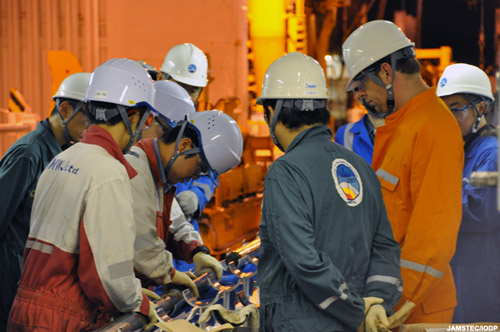
There is a wide distribution of coalbeds along the western margin of Eurasian plate, stretching from the Sea of Okhotsk to the South China Sea.
These coalbeds originate from plant life on land and in shallow seas now deeply buried in the earth, and are in other words the forests beneath the sea floor. In the process where plant tissue transforms into highly pure coal a variety of organic matter is released, and it seems that deep below the sea floor there are microorganisms feeding off this organic matter. What kind of relationship exists
between the subseafloor forests and the microorganisms? If we form an understanding of the matter cycles of the earth itself, the future global environment and sustainable energy cycling systems may become clearer.
(Published online September 2012)
| Interviewee: Fumio Inagaki Group Leader, Senior Scientist, Geomicrobiology Group,Kouchi Institute for Core Sample Research,Japan Agency for Marine-Earth Science and Technology(JAMSSTEC). |
Organic compounds supplied by coal
Rich coal fields lay buried beneath the continental edge of the Western Pacific. From the southern tip of Hokkaido to the coast off Hachinohe in Aomori Prefecture, thick coal beds are also lying in strata at depths of even more than 2,000m beneath the surface. Coal is formed when plant matter on land gets buried deep underground and matures through underground pressure or heat. Good quality coal consists of lumps of almost pure carbon. Broadly speaking, the bodies of living organisms are made up from carbon and nitrogen, hydrogen and oxygen. In other words, coal is formed when mainly elements such as hydrogen and oxygen disappear from the bodies of living organisms and carbon remains. Organic matter that has been buried in ancient times turns into coal while releasing various low molecular weight compounds.
Wood is impossible to eat for most living creatures. It is a different story however if it is turned into simple organic matter or inorganic compounds. Could the coal at this stage of maturity be a source of food for the microorganisms living in the small cracks in the deposits and rock deep in the earth? The IODP expedition 337: Deep Coalbed Biosphere off Shimokita from July 25 – September 30, 2012 intended to investigate exactly that.
Already in 2006, the CHIKYU went on an expedition for shakedown cruise on completion off the coast at Hachinohe, and confirmed the existence of vast numbers of microorganisms up to a depth of 350m beneath the seafloor, which is itself at a depth of 1,180m under water. According to Dr. Fumio Inagaki who lead the 2012 expedition as Co-chief Scientist, there are over 100 times more microorganisms compared to the seafloor deposits off the coast. “The reason that there are this many microorganisms will be because of the nutrients supplied by the diatomaceous sediment which has a high sedimentation rate and high water content, and by the underground coalbeds,” explains Inagaki.
The coalbeds are situated at 2,000m from the surface of the seafloor. These deposits of the Hachinohe coast are where photosynthetic organisms such as diatoms that inhabit the seawater’s surface layer settled as marine snow and formed deposits deep beneath the seafloor, or in other words, diatomaceous sediment. If sedimentation rates are high deposits will be comparatively new, even if they are deep underground, and organic matter that can make use of that, such as ancient life forms, will be plentiful. Of these, diatoms are phytoplankton which has siliceous shells. Diatomaceous sediment, which is formed from these deposited shells, is full of cracks because of these accumulations of tiny shells. “The presence of those many cracks means that water can easily move through it. In which case it is not only the supply sinking and settling from top to bottom that impacts on the subseafloor supply, but there may also be a system where nutrients coming from the coalbeds deep underground are supplied from the deep towards the surface layers. In Inagaki’s thinking, there is a dynamic world of the Hachinohe coast where organic material is supplied from coalbeds at a depth of over 2,000m beneath the seafloor to the seafloor surface.
- |1|
- 2|


